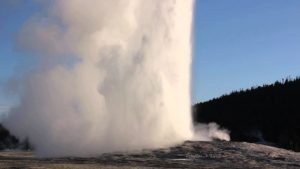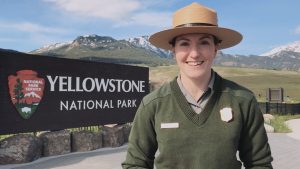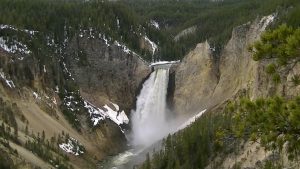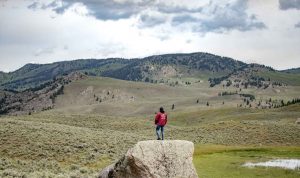Yellowstone is located at the headwaters of the Yellowstone River, from which it takes its historical name. In addition to driving around the park, exploring thermal areas, watching the wildlife, and viewing the scenery, there are several organized activities for park visitors to engage in. These are suggested tours I’d recommend to people who’d never been to Yellowstone before.
Yellowstone Itinerary in One Day
Table of Contents
Version 1: See as much as they can without investing too much time exploring
Start out by visiting the Old Faithful area. See the park’s namesake geyser erupt, then visit the historic Old Faithful Inn. Pick up a sandwich and chips at the Inn’s Deli, head up to the Mezzanine and eat (or head out to the car and drive to a nearby picnic area along the Firehole River). If you eat at the Inn, you can stop back in at the deli and pick up some ice cream before heading for the next half of your day.

When you’re ready, head south out of Old Faithful, through Craig Pass to the West Thumb Junction, then onto Lake Village and Fishing Bridge Junction. Head north through scenic Hayden Valley to Canyon Village. Stop in at the Visitor Center to learn about the volcanic origins of the park, then head down to the South Rim Drive (2nd drive south of the Junction on the Grand Loop Road). Stop and take in the sights at Artist Point. This is the location from which artist Thomas Moran painted one of the most well-known paintings of the Lower Falls. When you’re done, head back north to the North Rim Drive and stop at a couple of locations along this drive. Take the Brink of the Lower Falls trail if you have an hour or so to spare.
Version 2: Spend some time exploring one area a bit more in-depth
If you only have one day to spend in the park, then the Old Faithful area is the place to be. You can’t go to Yellowstone and NOT see its namesake geyser. Once you’ve seen the geyser, take the self-guided tour of the Upper Geyser Basin at least Morning Glory Pool. Stop in at the Lower General Store for lunch, then head over to the Old Faithful Inn.
When you’re done there, head up to Black Sand and Biscuit Basins, then up to Midway Geyser Basin to see Grand Prismatic. When done there, head up to Firehole Lake Drive, then stop in at the Fountain Paint Pots to round out the day.
Yellowstone Itinerary in Two Days
Day 1 begins in the northern part of the park. Begin by visiting Albright Visitor Center to get your bearings. Take the walking tour of historic Fort Yellowstone (or if you time it right, take the ranger-guided version), then head up to the Terraces. Take the Upper Terrace Drive motor tour. When done, head east toward Tower Junction, stopping at Undine Falls along the way. Stop at Tower Falls to see it, then head south over Dunraven Pass toward Canyon Village.
For lunch, you can either eat at the Mammoth Grill before leaving the Mammoth area or pick up a sandwich or hot dog at the Tower Falls General Store (they have a couple of picnic tables outside the store). You can also wait until you get to the Canyon area to eat a late lunch – there are several options for food there.

When you’re ready to begin the second half of your day, stop in at the Canyon Visitor Center to learn about the volcanic origins of the park, then head down to the South Rim Drive (2nd drive south of the Junction on the Grand Loop Road). Stop and take in the sights at Artist Point. This is the location from which artist Thomas Moran painted one of the most well-known paintings of the Lower Falls. When you’re done, head back north to the North Rim Drive and stop at a couple of locations along this drive. Take the Brink of the Lower Falls trail if you have an hour or so to spare. When you’re done, stay at the Canyon Lodge or head on to the Old Faithful area for your overnight accommodations (If you’ve not made advance reservations, you’ll probably need to head out to West Yellowstone for the evening. If you make reservations in the Old Faithful area, be sure to include dinner reservations at the Old Faithful Inn Dining Room).
Day 2 involves an exploration of the geyser basins. Go out and see Old Faithful erupt, then spend the rest of the morning exploring the remainder of the Upper Geyser Basin. For lunch, head over to the Lower General Store’s grill. When you’re done eating, head over to the Old Faithful Inn for a quick tour, then head up to Black Sand and Biscuit Basins, followed by Midway Geyser Basin to see Grand Prismatic. When you’re done there, head up to Firehole Lake Road, then over to the Fountain Paint Pots. This completes your two-day tour.
You can reverse this tour if you like. On sunny days during the summer, if you get out to Artist Point by 9 AM, you might see the rainbow that forms at the base of the Falls.
Yellowstone Itinerary in Three Days
Take the same tour outlined above for the first two days. You can begin Day 3 regardless of whether you end up in Canyon or Old Faithful the night before. This assumes you were staying in the Old Faithful area, however.
 Heading south from Old Faithful, stop at Kepler Cascades, then continue south to West Thumb. Take a tour of West Thumb, then head north to the Lake Village and Fishing Bridge area. You can eat lunch at the Lake or Fishing Bridge General Stores (both have eat-in grills and ice cream). If you stop at Lake, be sure to pop in and see the interior of the Lake Hotel. Head east along the northern shore of the Lake to see the wildlife, stopping at the Lake Butte Overlook for an excellent view of the Yellowstone Lake and the Grand Tetons (on a clear day).
Heading south from Old Faithful, stop at Kepler Cascades, then continue south to West Thumb. Take a tour of West Thumb, then head north to the Lake Village and Fishing Bridge area. You can eat lunch at the Lake or Fishing Bridge General Stores (both have eat-in grills and ice cream). If you stop at Lake, be sure to pop in and see the interior of the Lake Hotel. Head east along the northern shore of the Lake to see the wildlife, stopping at the Lake Butte Overlook for an excellent view of the Yellowstone Lake and the Grand Tetons (on a clear day).
Head back to Fishing Bridge Junction, then north into Hayden Valley to do some wildlife watching. You’ll want to stop at the Mud Volcano area to take in the sights, sounds, and smells. This will conclude Day 3.
Yellowstone Itinerary in Four Days
For a four day itinerary, I’d recommend beginning at the West Entrance (staying in West Yellowstone the night before if you can). Start out the day by taking a leisurely drive through the Madison Valley. When you get to Madison Junction, turn south and take the Firehole Falls Drive, then head back north to Norris Geyser Basin. You’ll spend a good chunk of time exploring this area, so you may wish to bring a sack lunch with you (Ernie’s Bakery/Deli in West Yellowstone has an excellent “Fisherman’s Lunch” that includes a sandwich of your choice with all the trimmings, chips, an apple, a candy bar of some type, a piece of bubble gum, and a soda. There are plenty of picnic areas along the roads throughout the park). When you’re done at Norris, continue north toward Mammoth. Stop at Obsidian Cliffs, Roaring Mountain, Sheepeater Cliff, and any of the other turnouts along the way. You’ll stay in Mammoth overnight, either at the Mammoth Hotel or one of their cabins. Eat dinner at the Mammoth Dining Room (no reservations needed).
 Get up the next morning and head over to the Albright Visitor Center to get your bearings, then take the self-guided walking tour of Fort Yellowstone (or if you time it right, you can take the ranger-guided tour). When you’re done there, head over to the Terraces, taking the walking tour of the Lower Terraces, drive up to the Upper Terrace Drive for the motor tour, and then head back into Mammoth for lunch. Eat lunch at the Mammoth Terrace Grill.
Get up the next morning and head over to the Albright Visitor Center to get your bearings, then take the self-guided walking tour of Fort Yellowstone (or if you time it right, you can take the ranger-guided tour). When you’re done there, head over to the Terraces, taking the walking tour of the Lower Terraces, drive up to the Upper Terrace Drive for the motor tour, and then head back into Mammoth for lunch. Eat lunch at the Mammoth Terrace Grill.
Head east toward Tower Junction, stopping at Undine Falls along the way. When you get to the Junction, continue straight to Tower Falls. You’ll want to see it while the sun is higher in the sky. When you’ve absorbed that, head back to the Junction and on toward the Northeast Entrance into Lamar Valley. Lamar Valley teems with wildlife, and you’ll spend the balance of your day along this road. If you continue all the way through to the Northeast Entrance itself, you’ll pass through some incredible mountain scenery.
When you’re done, head back to Tower Junction, then south through Dunraven Pass to Canyon Village where you’ll spend your evening.
Day three will begin with tours of the Canyon area, including trips along the South Rim Drive and North Rim Drive. Take your time in these areas, and finish up around lunchtime, eating at either the Lodge Cafeteria or the Grill at the General Store. Once you’re done eating, head south through Hayden Valley for more wildlife viewing opportunities. At Fishing Bridge Junction, turn east and head out along the northern shore of Yellowstone Lake. Turn up to the Lake Butte Overlook for an excellent view of the Lake itself and the Grand Tetons off in the distance, then head down to Lake Village and take a quick tour of the historic Lake Hotel. If you’re staying in the Lake Area, your day is done – you can spend any extra time exploring the Lake, Fishing Bridge, and Bridge Bay areas if you like. Dining at the Lake Hotel Dining Room is an excellent, though expensive choice (the bill can easily approach $100 for two adults with a tip). It will be less expensive to eat in the Lake Lodge Cafeteria.
Alternatively, you can stay in the Grant Village area that night, keeping in mind that it is an additional hour’s drive south of the Lake. Grant Village has a restaurant with a nice view of the lake (no reservations required).
On Day Four, get up and head to West Thumb for a quick tour (an hour south from Lake, or five minutes north of Grant). When you’re done there, head east to the Old Faithful area. Once there, you can watch the park’s namesake geyser erupt, take a tour of the Old Faithful Inn, and explore the Upper Geyser Basin. Eat lunch at either the Lower General Store, the Old Faithful Dining Room (or pick up a sandwich at the deli), or the Snow Lodge, then head north to see Black Sand and Biscuit Basins, then continue north to Midway Geyser Basin, Firehole Lake Drive, and Fountain Paint Pots before concluding your day.
If you can manage it, I’d highly recommend staying that night at the Old Faithful Inn and eating in the Inn’s Dining Room.
Yellowstone Itinerary – Side Trips
There are several side trips you can take that will eat up half days or entire days to add onto to any of the recommended itineraries above. These include:
- Hiking up to the summit of Mt. Washburn. This will eat up the major chunk of one day.
- Hiking to any one of a number of Falls throughout the park, including Fairy or Mystical. These will take half a day, especially if you take a lunch with you and eat at the Falls.
- Hiking the Artist Paint Pots trail, which will eat up a couple of hours.
- Hiking through Norris Geyser Basin. The front half of the tour can take up to two hours. If you add the back portion (Steamboat, Echinus, etc.), it can add another couple of hours as well.
- Driving up to Beartooth Pass. This will eat up a good part of the day as well, but the views and the scenery along the way are incredible. If you don’t spend much time in Lamar Valley on the Four-Day Itinerary, this makes a great add on before heading back into the park and down to Canyon Village.
- Of course, you can add any number of other activities to your itinerary at your discretion. There are scenic boat rides on the Lake, horseback rides, guided bus tours, ranger talks and demonstrations, and of course, there are a huge number of trails throughout the park, some of which require staying overnight in the backcountry. Most of the campgrounds have a ranger presentation around 9:00 or 9:30 in the evening during the summer (see the park newspaper insert for specifics).
- If you get up extra early one morning, especially if you’re staying at Mammoth or Canyon, and can get out to Lamar Valley, you might catch the wolves playing around.
- You can add a trip down to Grand Teton National Park (or finish there if you’re flying out of the airport). It’ll take a good two hours to get into the meat of the park, and that long to get back into Yellowstone if you’re going that route. You’ll want 4-6 hours to go through GTNP, including taking the Jenny Lake Road and stopping at the Visitor Center. Add another hour if you want to go to the top of Signal Mountain, plus more time if you want to take a boat ride and/or any of the trails in the park.
Yellowstone National Park Facts & Figures
- The world’s first national park.
- 3,472 square miles/2,222,766.71 square acres in size (2,222,765.13 federal; 1.58 non-federal), larger than the states of Delaware and Rhode Island combined.
- 63 miles north to south; 54 miles east to west.
- 96% in Wyoming, 3% in Montana, 1% in Idaho.
- The core of the Greater Yellowstone Area (the largest and most nearly intact temperate ecosystem in the contiguous United States, still inhabited by every wild species present when Columbus reached the New World 505 years ago) , encompassing 12 million acres. Includes Grand Teton National Park, John D. Rockefeller, Jr, Memorial Parkway, seven National Forests, three National Wildlife Refuges, and a variety of other properties.
- Approximately 5% of the park covered by water; 15% by grassland; and 80% by forests
- Precipitation ranges from 10 inches (26 cm) at the north boundary to 80 inches (205 cm) in the southwest corner
- Temperatures: Average at Mammoth: January: 9ºF July: 80ºF Records: High: 99ºF, 2002 (Mammoth) Low: –66ºF, 1933 (West Entrance, Riverside Station)
